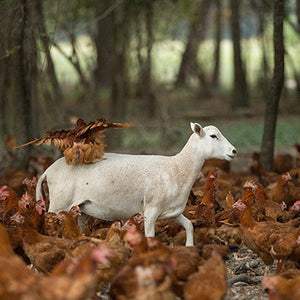This article is part of our first-ever EPIC Impact Journal. For more on this groundbreaking publication and how to get your hands on one, click here.
Isolation does not breed success on the farm — no matter what modern, mechanized agriculture models say. Since humanity transitioned from hunter-gatherer civilizations to early agrarian communities, people have always operated multi-species and multi-crop operations. Only in the last century have many farms converted to the single-crop, monoculture approach that rebuffs our world’s natural synchrony and destroys ecosystems. But just as their ancestors did for thousands of years before them, greater amounts of farmers and ranchers are realizing that integrating multiple species into their operations is the most efficient, productive, and healthy form of land stewardship.

A multitude of animals belong on a farm because each serves a specific role in large-scale land health. For instance, cows, goats, sheep, pigs, chickens, and turkeys should all be there. You can even mix in some bison if you don’t have sheep (since they can spread harmful diseases to one another). Cows and bison are the key ruminant actors, responsible for aerating topsoil with their hooves while infusing their specialized, potent fertilizer into the land. Without them, grasslands couldn’t grow as robustly and regenerative agriculture wouldn’t exist. Goats and sheep, while also ruminants, are like nature’s weed-eaters: they gobble up every weed or piece of brush they come across. They’re vital to sustaining healthy pastures and reclaiming areas that have been overtaken by woody and invasive vegetation. Next up, the chickens and turkeys. No matter what the industrialized operations that push for ‘vegetarian-fed’ chickens say, these poultry pickers play a crucial role in the fields by eating insects and scavenging through the droppings of the other animals. This doesn’t just give them a hearty diet — it helps debug pastures and orchards and spreads manure around while killing off dangerous parasites. Finally, there’s the pigs. Though they’re not the cleanest bunch, they can also play a critical role in farm health by rooting (digging up roots with their snouts), which tills soils and helps clear land. Collectively, these animals form a pasture maintenance crew that no machine or chemical can match.
This isn’t a heartfelt story of natural collaboration: it’s about efficiency. Animals such as horses, goats, sheep, and cattle all graze on different parts of pasture and vegetation, so none of them are as effective land stewards when raised in isolation. For instance, horses are selective eaters and tend to overgraze their favorite spots rather than spreading out their feeding areas. This can leave acres of underutilized and even untouched forage that farmers are forced to kill off with herbicides that degrade land and soils over time. Because goats and sheep instinctively target weeds and invasive brush species that encroach on pastures, they’re the perfect way to address underutilized forage or revive eroding pastureland. Of course, these animals couldn’t improve land health without the powerful droppings of cows and bison, and they would be subjected to greater risk of disease if chickens weren’t there to kill off the parasites. This efficiency isn’t accidental — it’s a byproduct of the fact that these animals have always existed together in nature.

A chicken catches a ride on a sheep at White Oak Pastures.
Multi-species operations are more productive, too. Every animal’s role in the pasture creates a compounding effect on its peers’ capabilities. As was previously discussed, chickens consume a more balanced diet while making the cows’ fertilizer more effective, goats and sheep boost pasture health while consuming brushy vegetation, and so on. These symbiotic relationships allow producers to focus less of their time and resources on destructive and expensive shortcuts (like chemical sprays, antibiotics, and lab-made feeds) and more on planned rotational grazing and holistic management. When it comes to life on the pasture, a natural remedy is always the best prescription.
Joint animal impact creates healthier pastures, soils, and ecosystems. As their relationships can attest to, every animal on multi-species operations serves a purpose in ensuring their lands are healthy, strong, and resilient. Similarly to humans, these animals are stronger together and were meant to share their pastures, not exist in isolation. Bringing cows, goats, sheep, chickens, pigs, and bison — if sheep aren’t present — together is a recipe for greater land health and a brighter future for future generations. It also ensures our food comes from farms and ranches that operate holistically and look out for animal welfare, unlike the mechanical feedlot model that has overtaken big ag and is stripping our planet of vital resources. It’s pretty straightforward: why separate our animals if keeping them together is more efficient, more humane, and better for our bodies and planet?
Of course, multi-species operations are not flawless. They require a greater deal of energy and attention to detail, and can pose logistical problems when it comes to things like fencing — different types of fencing is more effective with some animals than others, for instance — water consumption, and rotational grazing. They also can be more difficult to market and, when implemented and managed poorly, can be vulnerable to inter-species diseases (like those transmitted between bison and sheep). But when you consider the vast number of advantages that integrating animals brings to pasture health and business capability, it’s clear these issues are dwarfed by their large scale benefits.
 Pigs and chickens are happy to do the dirty work necessary to keep pastures healthy.
Pigs and chickens are happy to do the dirty work necessary to keep pastures healthy.
The concept of multi-species farms sounds complex at first glance, but it couldn’t be simpler. Think about the children’s song “Old MacDonald Had a Farm.” The farmer in it has cows, pigs, ducks, chickens, lambs, and goats. Considering a toddler can grasp the concept of bringing animals together, the rest of us need to get with the program.
Oh, and Old MacDonald: it’s about time you get yourself a bison.




 Pigs and chickens are happy to do the dirty work necessary to keep pastures healthy.
Pigs and chickens are happy to do the dirty work necessary to keep pastures healthy.